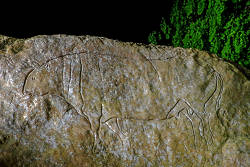Riparo di Romito
Grotta Del Romito
Useful Information
| Location: | Near Papasidero, Cosenza. |
| Open: |
Summer daily 9-13, 16-20. Winter daily 9-17. [2008] |
| Fee: |
Adults EUR 2,60. [2008] |
| Classification: |
 Karst Cave Karst Cave
|
| Light: |
 Incandescent Incandescent
|
| Dimension: | |
| Guided tours: | |
| Photography: | |
| Accessibility: | |
| Bibliography: |
F. Martini (2002):
Grotta del Romito,
Ed. Museo e Istituto Fiorentino di Preistoria, Firenze, 2002 |
| Address: | Riparo di Romito, Papasidero. |
| As far as we know this information was accurate when it was published (see years in brackets), but may have changed since then. Please check rates and details directly with the companies in question if you need more recent info. |
|
History
| 1961 | cave rediscovered by Agostino Miglio, the head of the museum of local history. |
| 1961-1968 | excavation by Paolo Graziosi from Florence University. |
Description

The Riparo di Romito is a 34 m long overhanging rock, followed by a 25 m long cave. Not very impressive from the speleological point of view, but a world famous paleological and archaeological site.
The cave was rediscovered for science by Agostino Miglio, the head of the museum of local history in Castrovillari. He got a hint from two locals Gianni Grisolia and Rocco Oliva from the village Papasidero. It seems the cave was known to the locals all the time, but they did not imagine its importance. After it was discovered an excavation campaign of seven years started, followed by others, and the work still goes on. The first excavation was made by Paolo Graziosi from Florence University.
The cave contains numerous remains of plants, animals and human visitors. This allowed the reconstruction of the climate and the culture of the people living here between 18,000 and 1,000 BP, the Late Stone Age. The single most important find are some engravings, especially two sketches of bovidae (Bos primigenius). The engravings were covered by cave sediments most of the time, which explains their extremely good preservation. Other finds include tools of daily use and items of burial rites.
The cave also contained some graves, which are distributed all over its floor. Two graves contained the skeletons of couple, one was between 15 and 20 years old, the other couple about 30 years old. Other graves contained single young men. All the buried people were only between 1.40 and 1.55 m tall, some even smaller. The skeletons, are on display as they were found, but only copies of the bones. The originals finds are now in the regional museum at Reggio di Calabria and in Florence.
The cave was was repeatedly used for a certain time, and then abandoned. One of those periods of intensive use was around 1000 AD, when the cave was used by eremites. A legend tells, that they were monks from the nearby monastery Sant’Elia. This is also the explanation for the name of the cave: the Italian word eremita was was altered during centuries into romito.
 Search DuckDuckGo for "Riparo di Romito"
Search DuckDuckGo for "Riparo di Romito" Google Earth Placemark
Google Earth Placemark Romito Cave - Atlas Obscura (visited: 22-JUN-2021)
Romito Cave - Atlas Obscura (visited: 22-JUN-2021) Die Grotte/Riparo di Romito, Kalabrien, I (visited: 28-JUL-2011) by Franz Lindenmayr. (
Die Grotte/Riparo di Romito, Kalabrien, I (visited: 28-JUL-2011) by Franz Lindenmayr. ( )
) Index
Index Topics
Topics Hierarchical
Hierarchical Countries
Countries Maps
Maps